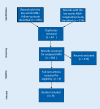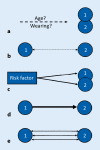Pathogenesis of multimorbidity-what is known?
- PMID: 32651847
- PMCID: PMC8458196
- DOI: 10.1007/s00391-020-01752-z
Pathogenesis of multimorbidity-what is known?
Abstract
Background: Multimorbidity is gaining increasing attention due to its substantial medical, healthcare political and social challenges. So far, however, there have been only few studies attempting to characterize the underlying pathogenesis.
Method: A selective literature search was carried out in PubMed.
Results: There is no generally accepted definition of multimorbidity. In the studies published so far, attempts have mostly been made to identify frequent clusters of diseases. In order to prevent multimorbidity, however, it is necessary to characterize the underlying mechanisms of development in more detail. For this purpose, a concept is presented based on the previously published data, in particular from longitudinal studies showing the importance of known risk factors. Possible pathogenetic processes involving multimorbidity are briefly discussed.
Conclusion: For most pathogenetic processes leading to multimorbidity there is no suitable pharmacological treatment available; however, behavior such as lack of exercise, dietary habits, smoking and high alcohol consumption are of considerable importance for the development of multimorbidity and can in principle be influenced by treatment.
Zusammenfassung: HINTERGRUND: Das Thema Multimorbidität gewinnt aufgrund der großen damit verbundenen medizinischen, gesundheits- und sozialpolitischen Herausforderungen zunehmend an Aufmerksamkeit. Bisher gibt es aber nur wenige Studien, in denen versucht wurde, die Entstehungsmechanismen näher zu charakterisieren.
Methode: Selektive Literaturrecherche in PubMed und einige Beispielberechnungen auf der Basis eigener Daten (GePsy-Studie).
Ergebnisse: Noch gibt es keine allgemein anerkannte Definition für Multimorbidität. In den bisher vorliegenden Untersuchungen wurde vor allem versucht, häufige Kombinationen von Erkrankungen (sog. Cluster) zu identifizieren. Zur Prävention und Behandlung der Multimorbidität ist es aber notwendig, die vielfältigen Entstehungsmechanismen näher zu charakterisieren, um so eine Differenzierung vornehmen und entsprechende therapeutische Strategien entwickeln zu können. Hierzu wird ein Konzept vorgestellt, das auf den bisher publizierten Daten, insbesondere aus Verlaufsstudien beruht. Diese zeigen die Bedeutung bekannter Risikofaktoren. Mögliche, einer Multimorbidität zugrundeliegende pathogenetische Prozesse werden kurz dargestellt.
Schlussfolgerungen: Die vielfältigen pathogenetischen Prozesse, die zu einer Multimorbidität führen können, sind bisher medikamentös kaum beeinflussbar. Aber Verhaltensweisen wie Bewegungsmangel, Ernährungsgewohnheiten, Rauchen und hoher Alkoholkonsum sind für die Entwicklung einer Multimorbidität von erheblicher Bedeutung und prinzipiell therapeutisch beeinflussbar.
Keywords: Harmful behaviors; Model of concepts; Multimorbidity; Risk factors; Therapeutical implications.
© 2020. The Author(s).
Conflict of interest statement
T. Wetterling declares that he has no competing interests.
Figures



References
MeSH terms
LinkOut - more resources
Full Text Sources
Medical

